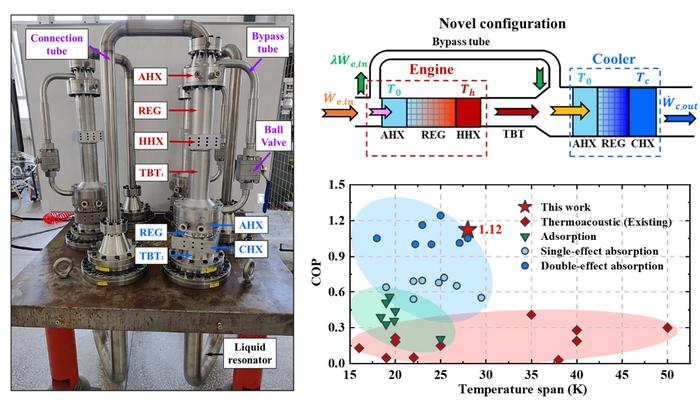Researchers led by Prof. LUO Ercang from the Technical Institute of Physics and Chemistry (TIPC) of the Chinese Academy of Sciences and their collaborators have developed an innovative heat-driven thermoacoustic refrigerator (HDTR) with a novel bypass configuration that significantly improves the efficiency of this technology.

Credit: TIPC
Researchers led by Prof. LUO Ercang from the Technical Institute of Physics and Chemistry (TIPC) of the Chinese Academy of Sciences and their collaborators have developed an innovative heat-driven thermoacoustic refrigerator (HDTR) with a novel bypass configuration that significantly improves the efficiency of this technology.
The study was published in Cell Reports Physical Science on Feb. 1.
HDTR is recognized as a new, promising cooling technology with many advantages. For example, it has no moving parts, uses eco-friendly substances (e.g., helium and nitrogen), and is highly reliable. However, its relatively low efficiency has hindered its commercial application.
The efficiency of HDTRs can be estimated by the coefficient of performance (COP), i.e., the ratio of output cooling power to input heating power. For existing advanced direct-coupled HDTRs, the researchers found an unexpected decrease in COP with increased heating temperature. Further, they uncovered the reason: there is a temperature matching constraint in these systems that prevents COP improvement at high heating temperatures.
To overcome this obstacle, the researchers proposed a creative bypass configuration to eliminate the temperature matching constraint. This novel configuration allows part of the acoustic power to be bypassed, thus realizing efficient acoustic power matching between the engine unit and the cooler unit at high heating temperatures.
As a result, the system achieves energy flow field synergy, which significantly improves efficiency. The researchers then built a kilowatt-scale HDTR prototype. Using helium as the working gas, they achieved a record high experimental COP of 1.12 with a cooling capacity of 2.53 kW, at the heating, ambient, and cooling temperatures of 450 °C, 35 °C, and 7 °C, respectively. This COP is 2.7 times higher than the best result ever achieved for existing HDTRs.
According to the researchers, in the field of room-temperature, heat-driven refrigeration, their new HDTR technology not only outperforms adsorption refrigerators and single-effect absorption refrigerators but is comparable to double-effect absorption refrigerators. These results highlight the great promise of this novel HDTR technology in commercial air conditioning applications.
Compared with helium, nitrogen is a more abundant, economical refrigerant with environmental friendliness. Therefore, the researchers also tested the system’s performance using nitrogen. The COP results are better than the previously reported by TIPC. The study was published in Applied Physics Letters on Jan. 8, and was specifically reported by Scilight.
The researchers claim that the novel HDTR system has an intrinsically higher COP than absorption refrigerators due to its efficient utilization of high-temperature thermal energy. Their numerical analysis suggests an outstanding potential COP value of 2 for the proposed HDTR system at a heating temperature of more than 800 ℃.
The researchers stated that they would make some modifications to the current system and increase the heating temperature to further improve the cooling performance of the system. After making that change, they anticipate achieving a COP that exceeds double-effect absorption refrigerators in the foreseeable future.
Journal
Cell Reports Physical Science
DOI
10.1016/j.xcrp.2024.101815
Method of Research
Experimental study
Subject of Research
Not applicable
Article Title
A highly efficient heat-driven thermoacoustic cooling system
Article Publication Date
1-Feb-2024




